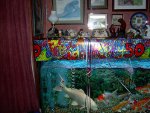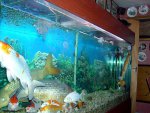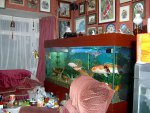Waterbug said:
I would agree if the OP had actually done this, but they didn't. When the OP said:
The implication and assumption that everything is going to be fine with their current methods and the defensiveness absolutely does indicate to me a statement of "see it works", that is at this moment.
Waterbug said:
It's only a challenging thread in this forum. Lots of other forums where container ponds are common and tons and tons of info on keeping Koi in small tanks. Google it. You'll be reading for weeks.
This is aboslutely not your basic setup, that is where concern to the fish's health is primary. Yes, there are tons and tons of info on
properly keeping koi in small tanks with many caveats that make them work.
Waterbug said:
I saw no claim of "see it works". Sounds more like OP doesn't know and wants to actually test to see if it works. And an offer to keep providing data. A perfect opportunity for readers to learn something...wasted.
This is what I am trying to do, but this attempt to be defensive in a conversation, which the reply to concerns absolutely have been defensive, to retalliate against folk who have seen these problems occur and are expressing their concerns quite strongly, and this retalliation is what is causing this discussion to be quite hallow.
Now, due to how particular statements and observations have been made, I am jumping to the conclusion that the author quite likely have not seen their fair share of fish, that is involving discussions pointing out actual deformirities, ailments, and incorrect behavior of healthy fish, to know the result of when a fish is improperly fed and managed as well as spotting other less obvious ailments. So, due to this, the statements of "appears healthy and happy" is quite meaningless to me.
Lets look at the actual data that has been shared thus far from, which is just barely scratching the surface here, quite poor notations lacking explanation. No mention of test results, other than saying everything is ok, nor pictures verifying. Now, the most recent post,
post#51, has been quite informative.
1) Some place in Canada (
post#1) , mild winters and told by others that basic aeration will prevent ice buildup with small snow accumulation (
post#51)
2) Outside Dimensions are 55" Long, 30" Wide and 22" Deep. It is approx. 115 US gallons. (
post#1)
3) Lost 2 fish in the first 2 weeks of transition (
post#7)
4) did a 20% water change when the 2 koi died. I have
not done a water change since. (
post#7)
5) currently have one ~15" goldsifh, three 6-7" koi, and two 5" butterfly (
post#7)
6) koi will be moved into a larger pond when they outgrow this one. (post#9)
7) feed the fish abuout 3 grams of food once, sometimes twice a day (that is
.1~
.2 ounces of food). The food is 28.8% Min protein. They eat the plants throughout the day (
post#51)
8) 3 large and 5 small hyacinth plants in there as well as 3 lillypad plants. (
post#1) and hyacinths have all died off due to cool weather (
post#51) and the water lillies have taken over (
post#7)
9) only using a 1000 gallon rated filter with bio balls (
post#1) with 10 2" bio balls in the filter (
post#24) and cleaned the filter twice thus far (
post#7)
10) added bacteria to the pond (
post#51)
11) wait and see how the water tests before deciding how many water changes (
post#1)
Now tell me how is this information any different than the typical begginer pond setup ?? ... which do result in problems eventually and the problems are shared almost daily here on this and other forums. What have you found that is meaningful and indicates the fish will be quite healthy for decades on end ??
I hope further testaments are shared in the future, both good
and bad, irregardless of the concerns already shared here, so to give proper information that we need to give readers an indication if this is the proper way to approach a pond. Granted, this is an experiment, but experiments are not disqualified from being viewed as if it could be the status quo.








